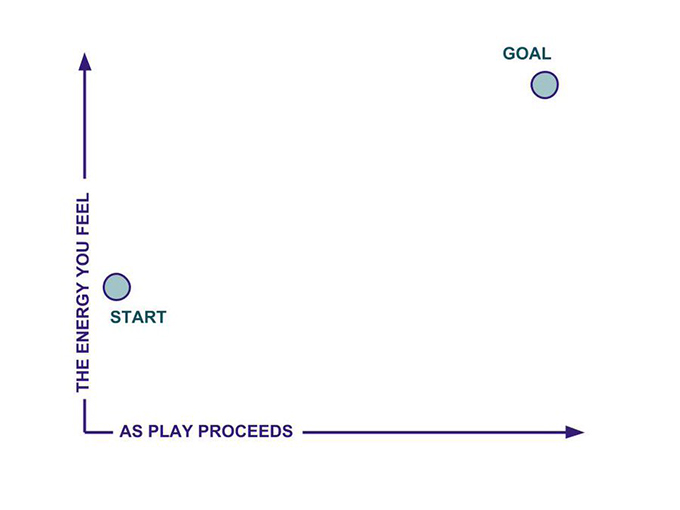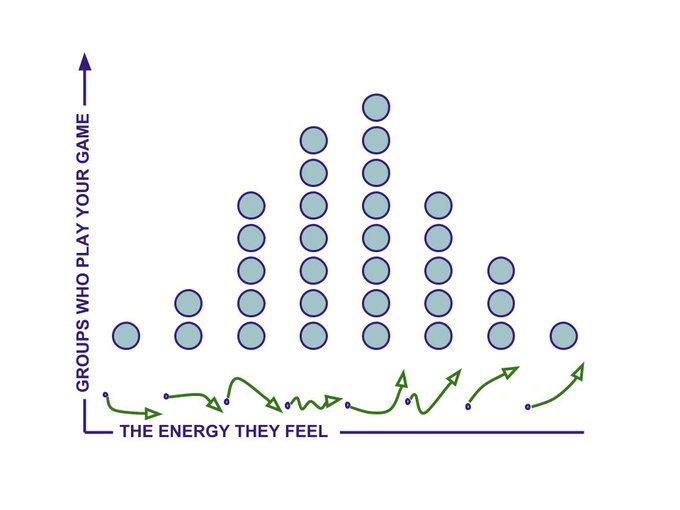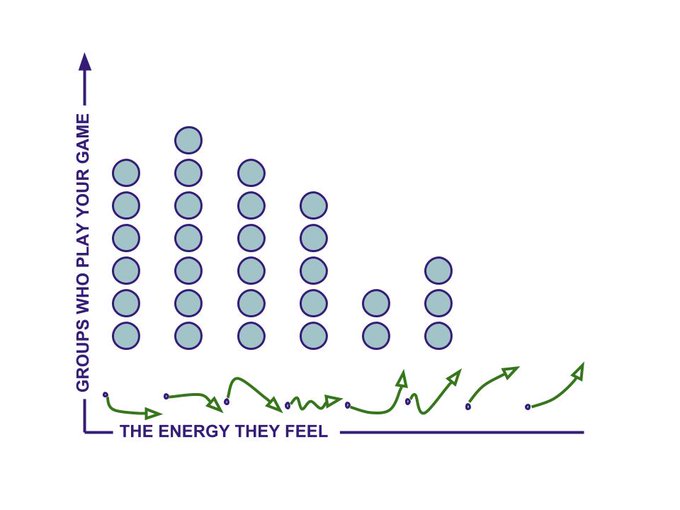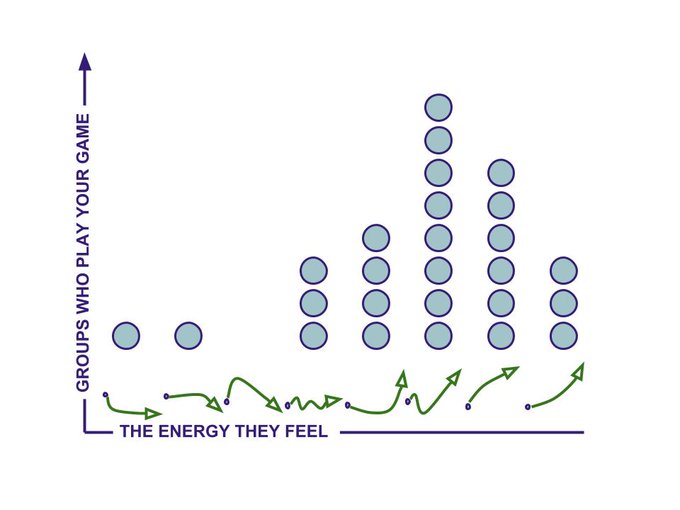This article was made possible by the generous support of our patrons. Please consider joining them by supporting us on Patreon.
For today’s purposes, let’s say that I care about one thing: the creative energy that a group feels while they’re playing my game.
Let’s say that they start at a receptive neutral, content to start the game but not yet won over. I want to win them over!

From that receptive neutral starting position, anything might happen. Any number of things! We don’t know what energy the group will feel as play proceeds.

But let’s pretend that we could somehow observe all the groups that play, list all the experiences they might have, and count how many groups have which experience.
I like to say that when you design a game, you design a bell curve of experiences, so let’s say this:

But here’s a distribution I DON’T want to design:

…And here’s a distribution that I DO want to design:

Now obviously there are a huge number of factors that are simply outside of my control. I can’t design whether the GM’s coming down with the flu or whether two of the players are feuding over something unrelated. I can’t design who has sleep deprivation and who’s raring to go.
I can design stuff like how you create your characters, what dice you roll, what permission the game gives you and what permission it withholds, what procedures it provides for negotiating each other’s creative contributions. A relatively small domain, really.
But still, as the designer, I really, really don’t want to design that other distribution, I really do want to design this one:

What do you think?
Is it possible? (I think it is.)
How do you go about it? How do you even begin to grapple with it?

Vincent Baker says:
This is from a thread on Twitter from the late teens. If you feel like you’ve seen it before, that’s presumably where!
Christopher A Barney says:
Timed release of game systems maybe?
You want to start not just with a strong narrative hook, but a strong mechanical one. Maybe that is a core system, or maybe it’s a character mechanic… For instance, when I proposed running a Vampire 5th edition game to some old-school WoD players I knew, I got a “Why would we do that?” When I described the new Hunger Dice mechanic I got “Oh! Now I want to try that!” Or when I run Invisible Sun by Monte Cook I find out what kind om magician players are interested in, and then I tell them a cool thing about how that kind of character has: “You get to put spell cards into your brain Tetris style” or “You can make up spells on the fly using the sources of magic you know”.
If I try to tell them about EVERYTHING in the system, they get overwhelmed, and their eyes glaze over. The problem, of course, is that in most systems, players kind of need to know most of the mechanics to play. If I were designing a system from scratch, I think I would design the core rules to be super compact, like a couple of paragraphs that describe the core hook mechanic. Then, I would design character progression to introduce the rest of the mechanics in a structured way over the first few ‘levels’ or really the first few play sessions. Literally, make the low levels the tutorial for all the core systems. Even in D&D they say, start at lvl 3 if you have experience… so I would include the rules to start with a more mechanically complete character if the players already know the system and are engaged.
Vincent Baker says:
Solid! That’s a pretty interesting prospect, using leveling up to gradually introduce the complete system.
Jon says:
Fun comes from excitement. Excitement comes from tension.
Tension comes from things with uncertain outcomes, like (out of game) putting your creativity out there for others to react to, or (in-game) taking a risk on dice or situations. Or from surprises – where an outcome seemed certain, but what happened went against your expectations, but still made sense in the new context.
You only need to put your earnest creativity out there or take an in-game risk if you need to solve a problem or address some kind of lack. Even then, you usually only bother if it’s a problem or lack that’s important enough to matter to you.
Important problems/lacks that matter to you are story. They’re the basis of a conflict. That’s what always thrilled me about PbtA design. It’s laser-focused on important problems/lacks that matter to you.
I feel like I need to build a game that connects what the players care about to what the mechanics make uncertain. Or (much harder) a game that finds ways to get the players excited about the stuff the mechanics make uncertain.
Vincent Baker says:
> I feel like I need to build a game that connects what
> the players care about to what the mechanics make
> uncertain. Or (much harder) a game that finds ways
> to get the players excited about the stuff the
> mechanics make uncertain.
Right on. I think that’s exactly the challenge.
Evan Torner says:
This also corresponds with how I structure convention sessions, which often means I leave the session on a cliffhanger or an all-too-easy resolution, because the slowdown in energy while the GM or players dither is antithetical to my existence. I think the escalation systems you’ve been building the past 20 years work well as part of this structure, but tend toward “cliffhanger” vs. “resolution,” whereas I see something like Yazeba’s B&B and think “Most of this is resolved *already* from the start, but we want to see how and what points of suspense come up despite that resolution…. including surprise cliffhangers!” I also don’t mind when games have a set dramaturgical structure: “First we’ll do this, then we’ll do this, and then we’ll come to this sort of decision.” It allows me to arc the character, and also push hard against the structure so that I can then be coerced into its embrace towards the end anyway.
Vincent Baker says:
It’s interesting to think about the overlap, but also the differences, between the problems a GM* has to face to make a high-energy session and the problems a designer faces. You want a game that supports GMs in their strengths, also inspires them, but maybe also provokes and challenges them.
* Or facilitator otherwise.
I think you’re absolutely right about escalation and cliffhangers. When I run Apocalypse World at conventions, I basically always shoot for a cliffhanger ending, not a resolution at all.
Ryan Stoughton says:
I’d really like your take on the difference between games where the GM gets more of a say in what the game is about. It’s easy to bash Gurps for being nonspecific, but I do wish there were games where the GM gets to mechanically consequential selections that tilt the design. (Rather than house rules that are written without any of the knowledge of the designer)
Ryan Stoughton says:
*Strikeout “the difference between “
Vincent Baker says:
(I’ve never really sat down with myself to figure out why I don’t care for explicit dramaturgy in my games. But that’s a personal problem, not rpg theory!)
Ryan Stoughton says:
Big ol’ Jenga tower
Vincent Baker says:
Hard to beat, seriously.
Timothy Mark Ralphs says:
I’m curious as to the stories each experience arrow suggests. For example, the third one along looks like a lot of initial excitement and then crashing disappointment – some sort of promise the game seemed to offer that was then denied. (I also notice that there’s a definite “The experience arrows get more preferable from left to right.” in the graph. Just making that explicit!)
Can I check in here though. Do you really want a group to feel at their most creatively energetic at the end of a session?
Vincent Baker says:
> I’m curious as to the stories each experience
> arrow suggests…
That’s sort of how I came up with those shapes! I thought of a little story like that and drew a line based on it.
> Do you really want a group to feel at their
> most creatively energetic at the end of a
> session?
If you want, I could say instead, at the end of a session I want them to have felt more creative energy over the course of play, than less. Or I could put the goal point at the climax of the session instead of the end of it, that’s fine too.
Josh Fox says:
It very much depends on the type of game. But I would suggest for a traditional campaign-oriented game you need this graph to be replicated across different components of the game.
Character gen: I want you to come out with more excitement than you went in.
First session: I want you to come out with more excitement than you went in.
Each subsequent session: same
End of first major story arc: same
So I want each component to create its own excitement. Character gen should be full of interesting choices and obvious things that the player is looking forward to seeing in play. First session should give enough of a glimpse of the mechanics to be excited to see more, and end on some kind of cliffhanger. And so on.
For campaign play, things like ongoing plot, unresolved threads, cliffhangers, and XP-type mechanics where I’m picking up new stuff that I get excited about for future sessions, all help to sustain interest.
One thing I think maybe needs capturing that the graph doesn’t explicitly pick up is anticipation. A fun session is a fun session and I always want that for players of my games. But anticipation of future fun is, I think, what keeps people coming back even if they have a low-energy session.
Vincent Baker says:
Ooh! Yes. Solid.
Daniele says:
I had the most amazing yet troubling experience with Downfall (by Caroline Hobbs) – an amazing game, by the way. In a couple of sessions I played, we were so happy and energized by the first half of the game (the worldbuilding part) that we agreed to stop there and savor that moment. That experience was the first thing that came to my mind after reading this post, not sure why.
Yesterday evening, I played Cowboy Bebop, and I was so tired that I would call the night after a couple of scenes. But then, something changed in the story: new NPCs arrived, the rules pushed us in a different direction, and — boom, I had more energy for a new round.
I think that’s one side of the problem about energy in tabletop RPGs – at least for me. Twists and detours, unexpected outcomes, surprises, wonders… call it in any way you want. But if they happen at the right moment, that might be a game changer. Also, if they happen and sustain the group’s effort, even better: if the energy is low, especially in those parts of the session where confusion and loss of ideas arise (mid-late game), rules that complicate the work players must do are a bummer. Instead, when rules simplify the work, when the energy is dropping and pushes you back into enjoying the game, you might feel as if you are flying.
It’s similar to the Chess theory of complications or simplifications. I’m terrible at chess, but those two concepts stroke my mind. One is not better than the other; it depends on the context: who’s winning, who’s losing, and what moment of the game we are in.
It also works very well as an ideal concept with the opposite situation: imagine you are flying along the session, the flow is amazing, and everyone is enjoying the game… and then, something in the system requires you to stop and detour in a bad direction. It could be very bad like many times happened to me in D&D with complicated rules after a good amount of combat scenes; it could be partially bad, like with Downfall – after a good “flying session,” the idea of reading new sets of rules (because we didn’t remember the second half of the game, we were so engaged in the worldbuilding) pushed us into “well, let’s end with a boom.”
One last example is Blades in the Dark: “Return to the Basic Roll.” You can always go back to the basics, and that’s helpful when things complicate too much during a moment in which we need system levity. At the same time, it gives you plenty of elements that help you sustain the fiction or twist it at the right moment – such as the Entanglements. As a GM, at that moment, I was so overwhelmed by the fiction we played that I surely am open to a system that gave me a hint at what could happen there.
Maybe system timing is the answer; that’s the TL;DR answer.
This is my first time commenting, so I’m not sure if my comment helps, so I just scrolled through the comments. Maybe someone has already touched this point; I’m sorry if that’s the case. But after years of lurking, I figured this was the first time I had something to say on a matter.
Vincent Baker says:
It’s a very insightful comment!
So as a designer, my take away from your comment is, I want to provide ways for the group to put on the gas when they need a boost of energy, ways for them to sustain their energy over a long and difficult or intricate process, and maybe to be flexible and opportunistic about how those things can happen.
Tommi Brander says:
This analysis is silent on how many groups are supposed to even try playing the game. You can make something that appeals to many or something that only a few care about, but those few really love (or hate) it. A smaller target audience allows for a sharper distribution.
…
In any case, and on a more fundamental level, I am not sure thinking of the energy of the group as a design goal. Maybe instead aim for clarity of purpose and suitability for it. Up to the group whether they suit the purpose or not, and if yes, they can probably make it work. Simply communicating the purpose of play seems an unsolved problem for roleplaying games, and far more pressing than group energy levels.
Routinely Itemised: RPGs #262 says:
[…] Vincent Baker shares In Brief, the Problem of RPG Design. […]
Theory review #168 – ropeblogi says:
[…] In brief, the problem of RPG design by Vincent Baker takes a high group energy level as the goal of roleplaying game design. https://lumpley.games/2024/06/18/in-brief-the-problem-of-rpg-design/ […]
christopher says:
I also feel that when the MC groks the game’s setting or touchstones, our games end up being highly energetic. The best game I’ve played in was Hearts of Wulin due to our MC having been steeped in wuxia films for basically his whole life. From his perspective, he later told me he thought his campaign was relatively generic, but from my perspective as player it was exactly as the rule book had described it would be. I’m guessing this is BECAUSE the MC hit all the generic touch points? I also ran a house-hacked PbtA game for a Dune / Metabarons style universe which produced exactly the kind of play / story you’d expect from that genre, and likewise had a ton of success with it.
Games we’ve struggled with / forced our way through have usually been the result of (imo) the MC not being deep into the genre. I ran a Night’s Black Agents-style alien vampire conspiracy game and it was *fine* but not great, which I attribute to the above.
CAR-PGa NEWSLETTER, Vol. 33, No. 7, July 2024 – CAR-PGA says:
[…] Vincent (2024 Jun 18) In Brief, the Problem of RPG Design. https://lumpley.games/2024/06/18/in-brief-the-problem-of-rpg-design. Designing games for rising […]
白竜 says:
I think your issue lies in the fact that too many games are at the core the same, and that is a logical fallacy of the industry, they assume you must start weak and progress on digging through holes to find xp and treasure of some kind and grow in personal power with out touching the world the game exists in. So you wind up with the cap level six year old because the child is king and the king must be always higher level than the characters. This is a major flaw, as first level does not equate to political or military power on a world. Bruce Lee never lead armies and Muhammed Ali was never president, despite being some of the best fighters ever to live. Which leads to the next fallacy, which is characters feel like middle school drop outs, struggling to become even functional members of society as at the beginning even common guards and other successful professionals are more skilled than they are. This generally is the repeated cycle of most all ttrpg and it is tired.